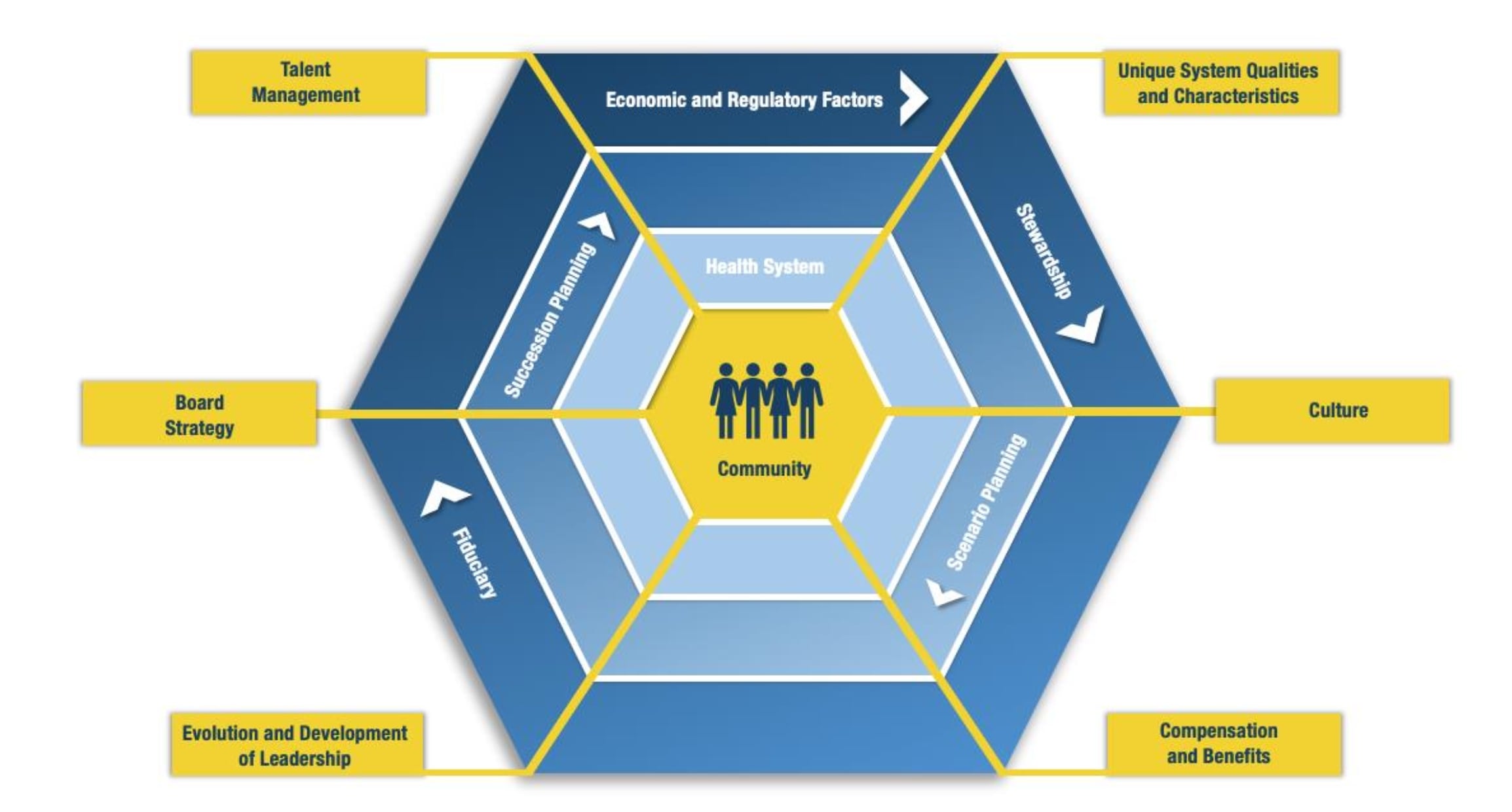The healthcare industry is at a very pivotal moment in time. Industry experts are projecting that 80% of all healthcare system CEOs will retire or transition out of their current position in the next five years, resulting in vacancies in many desirable positions for the first time in years, if not decades. Couple this with the fact that healthcare talent is highly marketable to other industries — healthcare talent navigates high-pressure environments, low margins and constant change — yet other industry talent is often not highly marketable in healthcare. As a result, the industry finds itself confronting a new world of succession planning.
At the recent American College of Healthcare Executives (ACHE) Congress, four esteemed panelists — Kristie Hartmann, Senior Vice President and National Healthcare Practice Leader at TRISCENDNP; Roger Nutter, President of Nutter Group; Stuart Harvey, Principal and Actuary at SullivanCotter; and Gerard Colman, Chief Executive Officer of Baptist Health System Inc. — convened to address the vital topic of succession planning in healthcare. Facing a multitude of challenges — including significant leadership turnover, high costs and low margins, and ongoing staff shortages — tax-exempt healthcare systems are confronting the urgent need to develop effective and comprehensive yet fluid succession planning strategies. This session provided a platform for these experts to share their experiences, insights and innovative strategies essential for maintaining leadership continuity and organizational resilience during transformative times.
A Deeper Look at the Challenges: Why Do So Many In the Healthcare Industry Believe that Succession Planning Is Inadequate?
For years, if not decades, many healthcare systems have enjoyed the benefit of highly competent, devoted and stable leadership. In fact, Colman recalled the healthcare industry bracing for the looming “great retirement” of the baby boomer generation 10 or so years ago. However, as leaders extended their tenures, this “great retirement” never eventuated, or at least not to the scale predicted. For many, focus shifted away from the perceived urgent need for meaningful succession planning to other critical matters.
Fast forward to today, however, and the tsunami of retirements is barraging to shore at increasing speed — putting pressure on boards, committees and senior leadership to bring succession planning back to the forefront of critical system and governance-related functions.
Additionally, with an ever-changing political, economic and regulatory environment, coupled with a constant connection to the demands of the role through phone, email, internal messenger, etc., the threat of burnout is real. In fact, studies suggest that the go-forward tenure of incoming leaders may very likely be considerably shorter than that of their predecessors as a result.
The idea of more frequent turnover in critical leadership positions places even more emphasis on the need for effective succession planning to ensure the seamless transition of knowledge and culture. This helps to preserve the intellectual capital that drives organization success, ensuring that healthcare systems can continue to thrive by serving their communities effectively and without interruption.
Lastly, a key issue that is often highlighted is the disproportionate focus on CEO succession, which tends to overshadow the broader necessity of effectively planning for all senior positions. Ultimately, without a more holistic approach to succession planning, a healthcare system is exposed to potential leadership gaps and a lack of readiness for inevitable transitions.
Understanding the Complexities of Succession Planning in Healthcare and the Need for a Community-Centric Approach
For the reasons outlined above, succession planning in healthcare is beginning to evolve beyond being reactionary — replacing the CEO and a few senior leaders when termination of employment occurs — to proactive. Trailblazing systems are beginning to develop strategic succession plans to position the system for smooth talent transitions as inevitable turnover occurs.
While the forward-planning efforts of these trailblazing systems should be applauded, those systems that feel as though they have a weakness in this area should likewise not be discouraged, as the complexities of succession planning are profound.
These complexities are vividly illustrated by the schematic below, which visually demonstrates the factors having a profound impact on the ability to adequately plan for succession.

As Hartmann explained, the beating heart of every system is the community that it serves. The two are completely interconnected, with the community reliant on the stability and longevity of the system for its health and well-being; while without the community, the system could not survive. Fundamentally, this means that every decision that the system makes, ultimately, impacts its community, and this includes adequate or inadequate succession planning.
Hartmann further elaborated that the need for fluidity in a succession plan is one of the more challenging components of developing and actioning a successful succession plan. For example, in the succession planning process, a system may have identified one or more potential successors to the CEO; however, due to the occurrence of one or more of the factors identified above, the system may find that the skill set of one or more of those internal candidates is no longer adequate to support the strategic plan of the system moving forward. The panelists are even aware of instances where the chosen successor ascends to the CEO role — only to find that once in the job, he or she is not cut out for it.
Ultimately, succession planning transcends simple personnel changes. As situations evolve — whether through internal developments or external forces — healthcare systems must be prepared for fluidity; thus, being willing to reassess and adapt their strategies, including succession plans, as necessary.
Thoughts on How to Enhance Your Succession Planning
As healthcare systems navigate the intricate dynamics of succession planning, the need for strategic foresight and actionable steps becomes clear. For those systems wondering how to improve their succession planning, the panelists recommended taking one or more of the following actions:
- Establish the Governance of Succession Planning. The most important step in a succession planning process is to start, and the panelists believe that succession planning starts with governance. Adequate succession planning should be a partnership between the board or compensation committee, the CEO and other senior leaders on his or her team.
- Designate a Specific Time for Succession Planning. Healthcare systems should make succession planning a regular and prioritized item on the agenda, the frequency of which will depend on the individual needs of the system in this area.
- Focus on Developing Trust and an Open and Honest Dialogue. The success of a succession plan can often depend, in part, on the trust and rapport between the parties, e.g., a board and the CEO. The development of trust allows for difficult conversations to take place. For example, the trust for a CEO to admit that his or her timeline to retirement is a particular period in length; and in making that admission, trust from the board that the CEO is now not a lame duck, does not need to be immediately replaced, and remains committed to the success and longevity of the system and a smooth leadership transition at the right time.
- Is the Team “Locked Down?” Many healthcare systems have strategic plans that are three to five years in length, and the success of that strategic plan can often rest on the leadership staying together and working to achieve the strategic objectives. This is an area where supplemental benefits come into play. While no one can guarantee that the extension of benefits will guarantee a leader, or leaders, remain with the healthcare system, it will certainly cause them to pause before they consider other opportunities. Most importantly, if the supplemental benefit is the result of a board directive, it is communicating to that senior leader that he or she is a valued member of the team and that the board wants that leader to continue service with the system. That is a very powerful message when external recruitment is so prevalent in today’s talent market.
The Path Forward
For healthcare systems, their boards and their senior leadership, now is the time to embrace these challenges as opportunities for growth and innovation in leadership development. By focusing on comprehensive, strategic processes that include all critical positions, healthcare systems can not only navigate current transitions but also set the stage for future stability and success.
For more detailed strategies on implementing effective succession planning in your organization, or to engage further with our experts, please contact TRISCENDNP at 972-318-1110.
Meet the Panelists
Kristie Hartmann
Senior Vice President and National Healthcare Practice Leader at TRISCENDNP, Kristie Hartmann brings a wealth of knowledge in supplemental benefit plans and succession planning. With a legal background, she helps healthcare systems nationwide navigate complex challenges, including the retention and recruitment of key executive and physician talent that drives the system’s continued success.
Roger Nutter
With a long career dedicated to healthcare executive search, Roger Nutter, President of Nutter Group, is known for his deep understanding of talent acquisition and leadership needs in the healthcare sector.
Stuart Harvey
A Principal at SullivanCotter, Stuart Harvey is an actuary with more than two decades of experience. Charged with leading the benefits practice, his work centers on aligning executive compensation and benefits with organizational strategies, making him a pivotal figure in leadership transitions.
Gerard Colman
As CEO of Baptist Health System Inc., Gerard Colman offers insights from the front line of healthcare leadership. His extensive background in operations and finance provides a comprehensive view of the organizational impacts of leadership changes.





